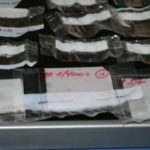Posts Tagged ‘Western blot’
The Essential Guide to In-Cell Westerns
In-cell Westerns are a powerful technique that has enhanced how researchers analyze protein expression levels and signaling pathways within fixed cells. Learn about their primary advantages, applications, and some of the best tech and products to perform them.
Read MoreHow To Make ECL Reagent: 4 Ingredients, Better Blots
ECL is an expensive reagent. Why not learn how to make ECL yourself? This cheap and simple option will give you better blots more often!
Read MoreConstant Current or Voltage in SDS-PAGE: The Great Debate
It’s not always easy deciding whether to run electrophoresis at a constant voltage, current, or power. Here, we outline the differences to help you make an informed decision.
Read MoreDon’t Let Bubbles Burst Your Experimental Excitement
Bubbles isn’t just the name of my favorite cartoon character from Power Puff girls, or just the best activity for a kid to play with, in general. In my adult world, they stand for a whole lot more, but can still cause extreme emotions. At the lab bench, seeing bubbles brings happiness or sadness depending…
Read MoreFluorescent Western Blotting: Lowdown and Advantages
In this article, you will be introduced to the world of fluorescent western blotting. Firstly, we will compare fluorescent and chemiluminescent western blotting. Then, we will learn how infrared fluorescent western blotting can give you truly quantitative and reproducible results. Lastly, we’ll look at the many advantages of fluorescent western blotting, including the possibility to multiplex. Importantly,…
Read MoreExtracting Better Ubiquitin Data from Your Samples: Beyond the Cellular Skip
The ubiquitin-proteasome system was discovered at the start of the 1980s, and people have been studying it ever since. Initially, researchers thought that tagging a protein with ubiquitin was the cell’s signal for the protein to be scrapped via the proteasome. But more research has shown that, as with all biology, once you’re up close and…
Read MoreHow to Scrutinize Your Glycosylated Proteins Without Using Glycosidases
You might have come across protein glycosylation before. Somewhere in the recesses of your memory you might even recall reading something about the protein you’re studying being glycosylated, but what does this mean and how do you analyze it? Glycosylated proteins are molecules decorated with sugar groups as they pass through the ER and Golgi…
Read MoreStripping Blots – It’s All Fun and Games Until Someone Loses Their Protein
Like all technical fields, molecular biology contains a very robust “theoretical” realm and an equally robust “practical” realm. Unfortunately, these two existences don’t seem to overlap as often as we’d like. Consider, for example, a simple Western blot. While an antibody interacting with its target on a membrane seems pretty straightforward, there are numerous other…
Read MoreSDS-PAGE Tips and Tricks to Save You Time
Speed up your SDS-PAGE with our time-saving tips and tricks!
Read MoreHow to Cherry Pick Your Primary Antibody
How do you pick which antibody you should use in your assay? If you’re starting a new assay and need an antibody for the job, then selecting a new antibody from the plethora available could be high up on your to-do list.
Read MoreThe Practical Guide to Running a Perfect Homemade SDS-PAGE Gel
As biochemists, we routinely run SDS-PAGE to analyze our proteins. Imagine the time and effort you are going to save when you can run every gel to perfection.
Read MoreWhere are My Bands? Troubleshooting a Signal-less Western
Western blotting uses electrophoresis and antibody-epitope affinity to give a semi-quantitative and (theoretically) clear measure of protein abundance. It’s a long procedure, filled with many steps—and even more room for error. Learning to troubleshoot certain problems is incredibly important for continued success with this technique. So what do you do when your final imaged product…
Read MoreNative Versus Denaturing Gels
We’re already gone through the basics of how gel electrophoresis work, compared common gel types like agarose and polyacrylamide and even explored some alternatives. Now let’s look at the native versus denaturing gels. You’ll be a speGEList in no time! Denaturing Gels We’ll start with this one, as it’s very self-explanatory. Denaturing gels are exactly…
Read MoreThe Lab Detective: Finding the Right Blot Detection Method
When it comes to registering the signal output of your Southern/Northern/Western/probe hybridization, you are spoilt for choice these days. You can go all retro and use X-ray film. You can go digital and use a phosphorimager. Finally, you can go fluorescent and use a fluorescence detector. So, what are the pros and cons of each…
Read MoreNon-specific Binding? Tips to Sharpen up Your Western Blot
In the previous installment of this series on western blotting, we addressed potential sources of error when your final product is completely bare. But alternatively, what do you do when too much background is the problem? You may have beautiful bands of interest—but if there is a bunch of non-specific binding, your quantification and data…
Read MoreEquilibrating your way to a perfect Western blot
If you are struggling to optimise your Western blot protocol, one step to consider is the equilibration of your gel and membrane before transfer. Wondering what this step achieves and whether it’s necessary? You’re not alone! I did dozens of Westerns without ever bothering to equilibrate before I realised that it was having a big…
Read MoreThe Top 10 Western Blotting Mistakes (and Solutions!)
Ever had a blot so bad it looked like a Rorschach test? We have ten things that might be going wrong with your western blots and how to fix them.
Read MoreTips for Choosing and Using a New Primary Antibody
Finding a good primary antibody can often feel like playing Russian roulette. Nothing is more disappointing than buying a $300 antibody that doesn’t work for your use. There are some steps you can take, however, to increase your likelihood of success. Scout out Other Labs Before you buy, ask if anyone around you or in…
Read More















